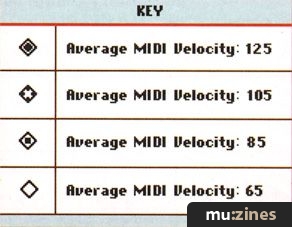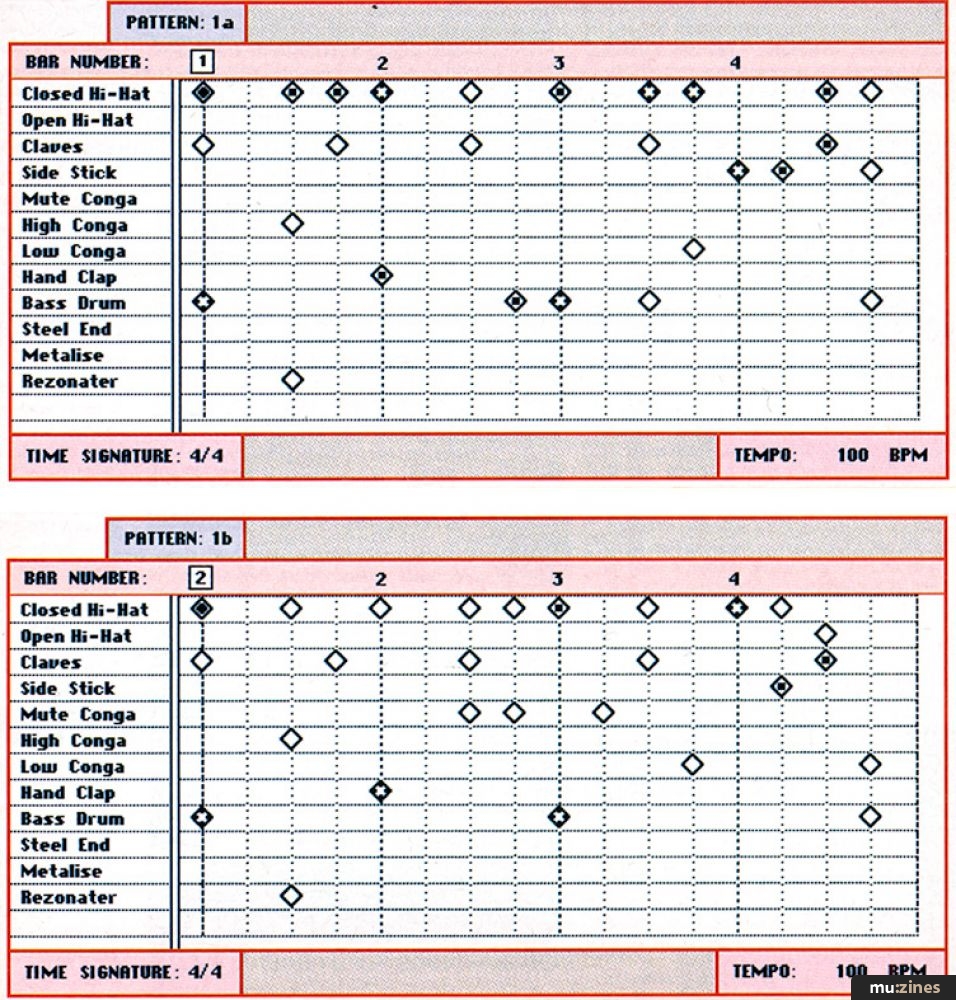Magazine Archive
Home -> Magazines -> Issues -> Articles in this issue -> View
Article Group: | |
On The Beat (Part 3) | |
the next generationArticle from The Mix, December 1994 | |
Part three of our guide to grooves
Happy coincidences can often be a great source of ideas in drum programming, so says Nigel Lord. In part 3, he urges you to introduce the element of chance into your music...

Among General MIDI's obvious advantages is its ability to guarantee a song will be replayed in coherent form, irrespective of which synth or sound module it is played back on. Nice as this is, it does have the effect of reducing the number of 'happy accidents' which occur, and can be such a source of inspiration in sequenced music.
Without GM, changing the channel assignments on a sequencer or multitimbral sound module often produces some fascinating results, quite unexpected when the original notes were entered. Yet just as often, the result is a cacophonous din, which threatens the cones of your monitors - but you have to take the rough with the smooth.
A technique I've found particularly fruitful is using individual lines from a drum pattern to trigger essentially non-percussive sounds as part of a rhythm track. And the best way I've found of doing that is simply combing through patch banks with the pattern playing, and seeing what emerges. There can be a problem trying to integrate pitched sounds into an existing track of fixed key ('though no more so than with pitched percussion instruments). But in general, most synths or sound modules are capable of generating a wealth of useable sounds which can completely transform a track and provide real rhythmic interest.
Thinking beyond the snare, bass drum and cymbals is actually a subject rather close to my heart, having spent almost four years of my life as editor of Rhythm magazine trying to convince drummers that their kits weren't the sole source of rhythmic/percussive sound. It seemed to me the most attractive feature of electronic percussion was not its ability (or inability, as most drummers saw it) to imitate acoustic instalments, but to provide a much broader palette of sounds from which to draw. For a while. I genuinely believed that drummers would be at the head of the queue for samplers, untroubled as they were by limited sampling times or restricted polyphony. As you can imagine, my enthusiasm was somewhat misplaced. To quote PG Wodehouse, I left the magazine feeling, if not disgruntled - not exactly gruntled either.
As I explained in the opening article in this series, I was also rather stymied in the original On The Beat series in Music Technology by being able to use only those sounds it was possible to describe on paper. With the coming of The Mix - and of course, Re:Mix - all that's a thing of the past. Well, it is if you have a sampler; if you haven't, you'll just have to listen closely to the sounds on the CD and try to come up with something as close as you can. Of course, it's equally possible that whilst doing this, you'll be blessed with one of those happy accidents, ending up with something equally useful - and totally original.
In general, I find that ambient sounds work best, and conversely, 'real' instruments are the most difficult to place. It's also possible to completely disregard a sound at a particular pitch, only to discover it works perfectly a couple of octaves up or down. Bear this in mind when experimenting.
You'll also find duration is a significant factor; most percussion sounds are designed to be played for their entire length regardless of how long the note trigger is. Consequently, trigger signals are often too short to play non-percussive sounds for anything like their natural duration. For this reason, for this kind of programming you'll have set your sampler to 'one-shot' trigger mode (or whatever it's called on your machine), or stick to sequencers (which can record notes of any length).
The other problem centres on those sounds which have time-related components; sounds that cycle or pulse - perhaps as a result of an LFO activity. Unless it's possible to adjust this as part of the preset, you may find the tempo of the pattern is restricted to a fixed BPM figure.
In fact, this is something that affects all three of this month's examples, which, as you can see, are only given single tempo figures. Move beyond these and you'll find the sounds don't mesh in correctly with the rest of the pattern, unless of course you have time-stretching facilities with which to modify their length/speed ratio.
But what of the rest of the patterns? Well, as you'll hear, they're a pretty hard-hitting bunch, chosen as much as anything to illustrate that there's no need to compromise a drum pattern simply to accommodate this extra sonic interest. Each of the examples stand up well as conventional rhythm tracks, and can be used in that way if required. But I think you'll find the addition of the ambient sounds more than justifies the programming/sampling time involved.
As far as the CD is concerned, the sounds are the correct duration to fit into the patterns at the tempo shown. Get them up and running as they stand, and think about changing pitch or tempo later. Above all, take care to trim off any blank space at the start of the samples, so that they're triggered at the rhythmically correct position in the bar. Even a few milliseconds can make a real difference here. Where possible, sample by using the auto-trigger function and setting an appropriate threshold level.
If you're not sure if there is any blank space at the top of the sample (and it isn't always easy to tell when you're dealing in milliseconds), try moving the relevant notes forward on your sequencer or drum machine, if this is possible. If there's a noticeable improvement, you may not need to bother trimming the sample - 'though, of course, every bit counts when it comes to sample memory.
Programming is quite straightforward, as you can see. Follow the key for velocity levels if you're new to the series, but be prepared to tweak notes between these four settings to get the patterns sounding how you want them. Be prepared also to adjust the overall levels of each instrument. Though they are all referenced to MIDI velocity levels, this doesn't take account of variations which may occur during recording of the CD or your sampling of the sounds. And anyway, your idea of the right mix is unlikely to be the same as mine. Experiment!

(Click image for higher resolution version)

(Click image for higher resolution version)

(Click image for higher resolution version)

(Click image for higher resolution version)
On The RE:MIX CD

The drum sounds that correspond to the On The Beat patterns can be found on the Re:Mix CD
- On The Beat Kits
Series - "On The Beat - The Next Generation"
Read the next part in this series:
On the beat (Part 4)
(MX Jan 95)
All parts in this series:
Part 1 | Part 2 | Part 3 (Viewing) | Part 4 | Part 5 | Part 6 | Part 7 | Part 8 | Part 9
More with this topic
 Tuning Your Breakbeats |
Rhythm and Fuse |
Beat Box |
The Rhythm Method - Beat Box Hits |
The Sounds Of Motown |
Off the Wall |
Beat Box |
Beat Box |
Beat Box Ballistics - Drum Machines |
Hands On: Roland TR808 Drum Machine |
Personalise Your Drum Machine Sounds - Masterclass - Drum Machines |
Beat Box |
Browse by Topic:
Drum Programming
Publisher: The Mix - Music Maker Publications (UK), Future Publishing.
The current copyright owner/s of this content may differ from the originally published copyright notice.
More details on copyright ownership...
Sound Advice
Topic:
Drum Programming
Series:
On The Beat - The Next Generation
Part 1 | Part 2 | Part 3 (Viewing) | Part 4 | Part 5 | Part 6 | Part 7 | Part 8 | Part 9
No Javascript: Audio player is disabled
Re:Mix #6 Tracklisting:
18 On The Beat Kit 1 19 On The Beat Kit 2 20 On The Beat Kit 3
This disk has been archived in full and disk images and further downloads are available at Archive.org - Re:Mix #6.
Feature by Nigel Lord
Help Support The Things You Love
mu:zines is the result of thousands of hours of effort, and will require many thousands more going forward to reach our goals of getting all this content online.
If you value this resource, you can support this project - it really helps!
Donations for April 2024
Issues donated this month: 0
New issues that have been donated or scanned for us this month.
Funds donated this month: £7.00
All donations and support are gratefully appreciated - thank you.
Magazines Needed - Can You Help?
Do you have any of these magazine issues?
If so, and you can donate, lend or scan them to help complete our archive, please get in touch via the Contribute page - thanks!
















